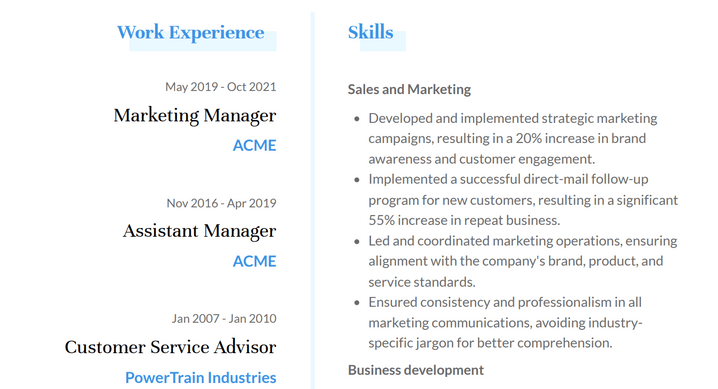
How to write a Hybrid Resume (with instructions, tips, and examples)

If you are looking for a great way to highlight your best skills on your resume while showcasing a clear timeline of your career, you may want to learn how to write a hybrid resume.
For some job-seekers, showing that you have the right skills for the job you are applying for can be difficult. If your most recent position isn’t directly related to the job posting, it’s important to list your transferable skills, but your most relevant accomplishments might not have been in your most recent job. This requires some creativity when structuring and formatting your resume.
Fortunately, there is a great way to show your best skills while retaining a clear career history: the hybrid resume format.
The hybrid resume format opens with a robust Skills section, ensuring your transferable skills are emphasized, then follows with a reverse-chronological Work Experience section, listing your past positions in a logical order.
This article will explore:
- Resume formats
- The hybrid resume format
- Reasons to write a hybrid resume
- How to write a hybrid resume
- Hybrid resume templates and examples
What is a hybrid resume?
A hybrid resume (or a combination resume) emphasizes skills while maintaining a clear timeline of past positions. This format blends the strengths of both functional and chronological resume, showcasing relevant key skills prominently while providing a concise history of work experience.
To fully grasp the Hybrid resume format, it's essential to first understand the other two main types of resume formats:
- Reverse-Chronological Resume Format: This is the most traditional and widely used format. It lists work experience starting from the most recent position and works backward. This format highlights a clear career progression and is favored by employers because it provides a straightforward timeline of the applicant's job history. Read more about reverse-chronological resume format here here.
- Functional Resume Format: This format focuses on skills and experiences rather than chronological work history. It groups relevant skills under specific categories, which makes it ideal for individuals with gaps in their employment history or those looking to change careers. Read more about functional resume format here.
The Hybrid Resume Format combines elements of both. It typically starts with a skills summary (like a functional resume) but also includes a detailed reverse-chronological work history. This format is beneficial for highlighting skills relevant to the job while still providing a clear employment history for employers.
The Hybrid resume
A hybrid resume, sometimes called a combination resume, is a resume that combines the best features of the functional resume format and the reverse-chronological resume format. It begins with a long, detailed Skills section (like a functional resume), but still retains a reverse-chronological Work Experience section (like a reverse-chronological resume).
In a hybrid resume, your Skills section will be positioned above your Work Experience section. It will also be longer and more detailed. Like a functional resume, it will have detailed examples in the Skills section rather than a simple bulleted list of skills, and like a functional resume, entries in the Work Experience section will be short and less detailed. Unlike the functional resume, however, past jobs will still be listed in order.
This allows you to showcase your skills without obscuring your dates of employment and career journey.
If you want to highlight skills rather than work experience, consider writing a hybrid resume.
Why should you write a hybrid resume?
You should write a hybrid resume if your career path has been unconventional or if your skills are more important than your career timeline. This format allows you to highlight key abilities while still providing a clear work history.
A hybrid resume allows you to emphasize all your best and most relevant skills right at the top of your resume with lots of detail, with less of a focus on the timing of specific accomplishments. This can be helpful when your most recent position isn’t directly relevant to the job you are applying to.
If you are changing careers, for example, a hybrid resume can help you highlight your most transferable skills better than your current position. Similarly, if you are returning to work after an absence, a hybrid resume will emphasize your existing skills. If you have a history of job-hopping, have worked in many different industries, or your work history has some long gaps in it, a hybrid resume format might work for you.
How to write a hybrid resume
Now that you know what a hybrid resume is for and when you should use one, you are ready to start writing. When it’s time to write a hybrid resume, follow these steps:
1. Write a brief summary
While not strictly mandatory, it is a good idea to start your resume with a Summary section whether you are using a hybrid resume format or not. This section should be short, no longer than a few sentences or bullet points, and punchy. This is where you introduce yourself to an employer, listing a few important qualities, skills, or highlights from your career. If done well, your Summary section can be what hooks an employer and convinces them to read the rest of your resume.

2. Focus on your skills
In a hybrid resume, your Skills section is the most important part of the resume. It should be the largest section of the resume, positioned high on the first page and written with lots of detail.
In your Skills section, identify your most relevant and most impressive skill areas. Make each skill area a heading, then list examples or explanations underneath. For example, if you are applying for a sales role, you may want to include a section such as:
Sales and Marketing
- Successfully conducted over 150 new and resale transactions, achieving sales volumes exceeding $25M and selling 48% of the project's condominiums within the first year at York Simpson.
- Overcame buyer challenges, such as high property taxes and HOA fees, to secure 5 offers within 24 hours at York Simpson.
- Generated awareness of new properties through targeted in-print and online marketing strategies, effectively reaching potential buyers and increasing property visibility.
- Utilized strong negotiation skills to secure favorable deals for clients, resulting in high customer satisfaction and repeat business.
- Consistently met or exceeded sales targets, demonstrating a strong ability to drive results and achieve business objectives.
When coming up with examples of your skills, focus on your achievements in past roles. Your past accomplishments should contain examples of the skills you want to highlight for the position you are applying for.
Try to use concrete examples of your successes. This should include quantifiable details, like sales, revenue, team size, project budgets, or customer success scores. Any measurable details from past jobs will look great on a resume. They show not only that you are successful, but that you measure your success and track your performance, all attractive qualities in an employee.
Further, when describing past accomplishments, use active language as much as possible. Action words like spearheaded, overcame, conducted, and negotiated all characterize you as an independent worker who can take initiative. The way you describe your accomplishments is almost as important as the accomplishments themselves.
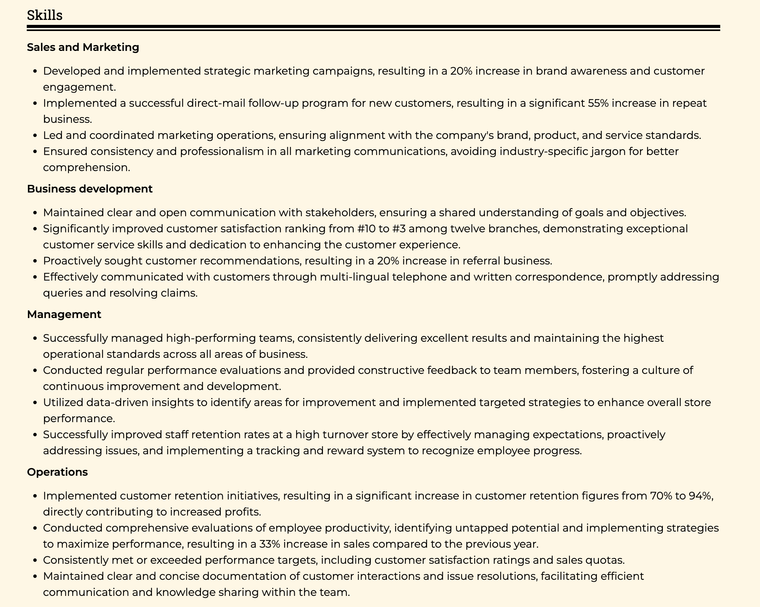
Throughout your Skills section, make sure to include both soft skills, the transferable skills that make you a great employee, and hard skills, the technical abilities that make you competent in your vocation. This will allow you to demonstrate that you are a well-rounded worker who would be an asset both in terms of your abilities and your personal attributes.
The Skills section is the centrepiece of a hybrid resume, so it’s important to get this section right.
3. List your previous work experience
In a hybrid resume, your Work Experience section is secondary to your Skills section. That doesn’t mean, however, that it isn’t important.
In your Work Experience section, list your previous positions in reverse-chronological order. For each item, include the
- Job title
- Company name
- Dates of employment
Because your key accomplishments are all listed in your Skills section, it isn’t necessary to add more detail to your Work Experience entries. However, if you feel some explanation is needed, you can add a bullet point or two with some details about the specific roles.
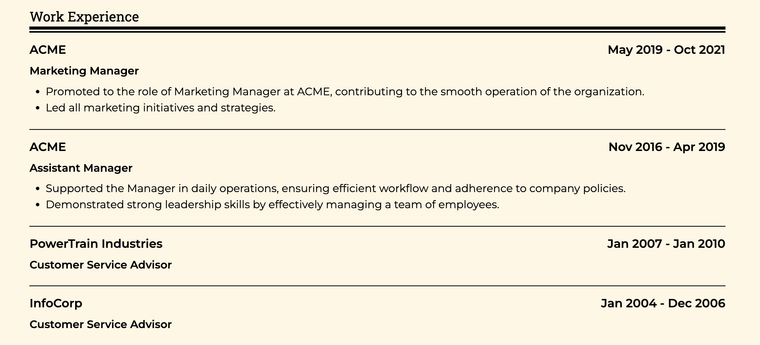
4. Show your education
It’s important to list your education in your resume, even if it isn’t directly relevant to the job at hand. Academic credentials can still impress employers. In your Education section, list your degrees in reverse-chronological order. For each item, include the:
- Degree
- Institution name
Dates are optional in your education section.
Hybrid resume example
Summary
Jordan Armstrong is a Marketing Specialist with a strong background in marketing and management. With experience as a Marketing Manager and Assistant Manager at ACME, Jordan has demonstrated expertise in developing and implementing successful marketing strategies. They hold a Bachelor's degree in Business Administration from State University. Their experience in marketing management, combined with their strong communication and problem-solving skills, make them a valuable asset to any organization.
Skills
Sales and Marketing
- Developed and implemented strategic marketing campaigns, resulting in a 20% increase in brand awareness and customer engagement.
- Implemented a successful direct-mail follow-up program for new customers, resulting in a significant 55% increase in repeat business.
- Led and coordinated marketing operations, ensuring alignment with the company's brand, product, and service standards.
- Ensured consistency and professionalism in all marketing communications, avoiding industry-specific jargon for better comprehension.
Business development
- Maintained clear and open communication with stakeholders, ensuring a shared understanding of goals and objectives.
- Significantly improved customer satisfaction ranking from #10 to #3 among twelve branches, demonstrating exceptional customer service skills and dedication to enhancing the customer experience.
- Proactively sought customer recommendations, resulting in a 20% increase in referral business.
- Effectively communicated with customers through multi-lingual telephone and written correspondence, promptly addressing queries and resolving claims.
Management
- Successfully managed high-performing teams, consistently delivering excellent results and maintaining the highest operational standards across all areas of business.
- Conducted regular performance evaluations and provided constructive feedback to team members, fostering a culture of continuous improvement and development.
- Utilized data-driven insights to identify areas for improvement and implemented targeted strategies to enhance overall store performance.
- Successfully improved staff retention rates at a high turnover store by effectively managing expectations, proactively addressing issues, and implementing a tracking and reward system to recognize employee progress.
Operations
- Implemented customer retention initiatives, resulting in a significant increase in customer retention figures from 70% to 94%, directly contributing to increased profits.
- Conducted comprehensive evaluations of employee productivity, identifying untapped potential and implementing strategies to maximize performance, resulting in a 33% increase in sales compared to the previous year.
- Consistently met or exceeded performance targets, including customer satisfaction ratings and sales quotas.
- Maintained clear and concise documentation of customer interactions and issue resolutions, facilitating efficient communication and knowledge sharing within the team.
Work Experience
Marketing Manager ACME May 2019 - Oct 2021
- Promoted to the role of Marketing Manager at ACME, contributing to the smooth operation of the organization.
- Led all marketing initiatives and strategies.
Assistant Manager ACME Nov 2016 - Apr 2019
- Supported the Manager in daily operations, ensuring efficient workflow and adherence to company policies.
- Demonstrated strong leadership skills by effectively managing a team of employees.
Customer Service Advisor PowerTrain Industries Jan 2007 - Jan 2010
Customer Service Advisor InfoCorp Jan 2004 - Dec 2006
Education
Bachelor of Arts in Business Administration State University
Hybrid resume templates
If you are still looking for inspiration, here are some hybrid resume template examples to help you get started.
Hybrid resume template example 1
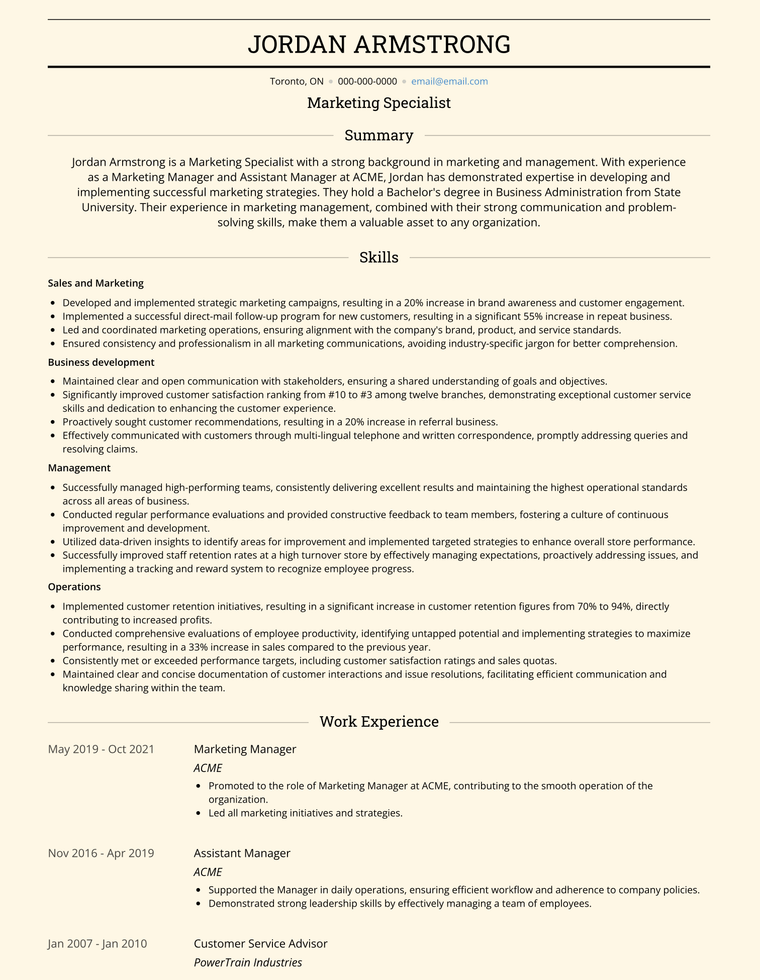
Hybrid resume template example 2
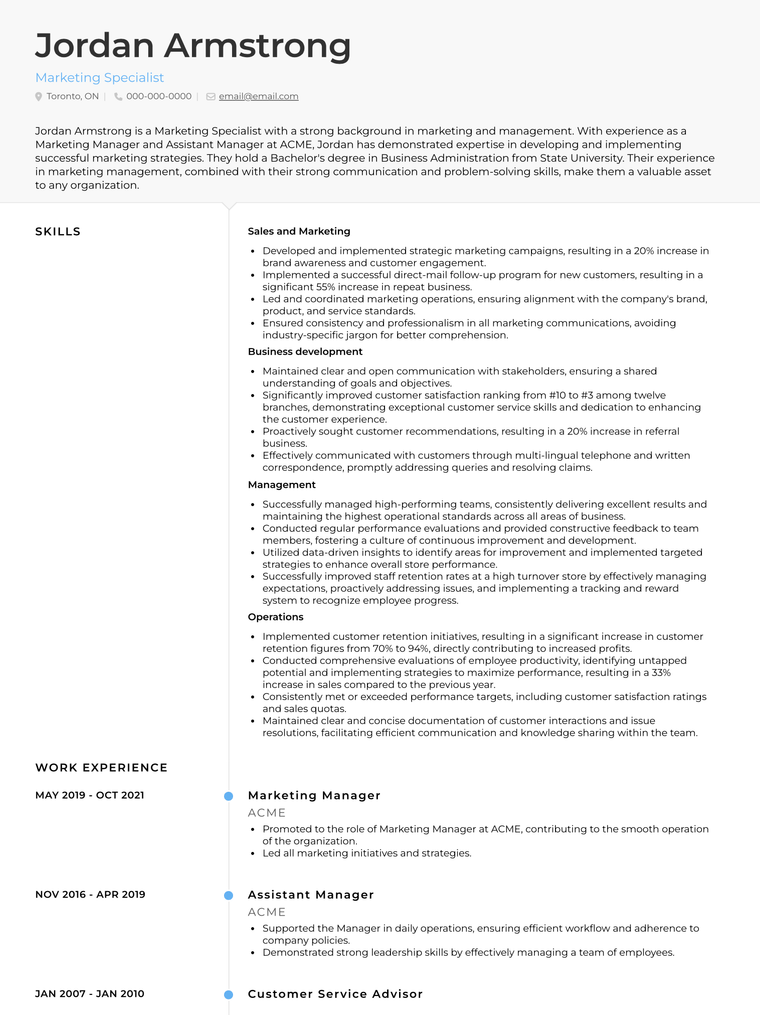
Hybrid resume template example 3
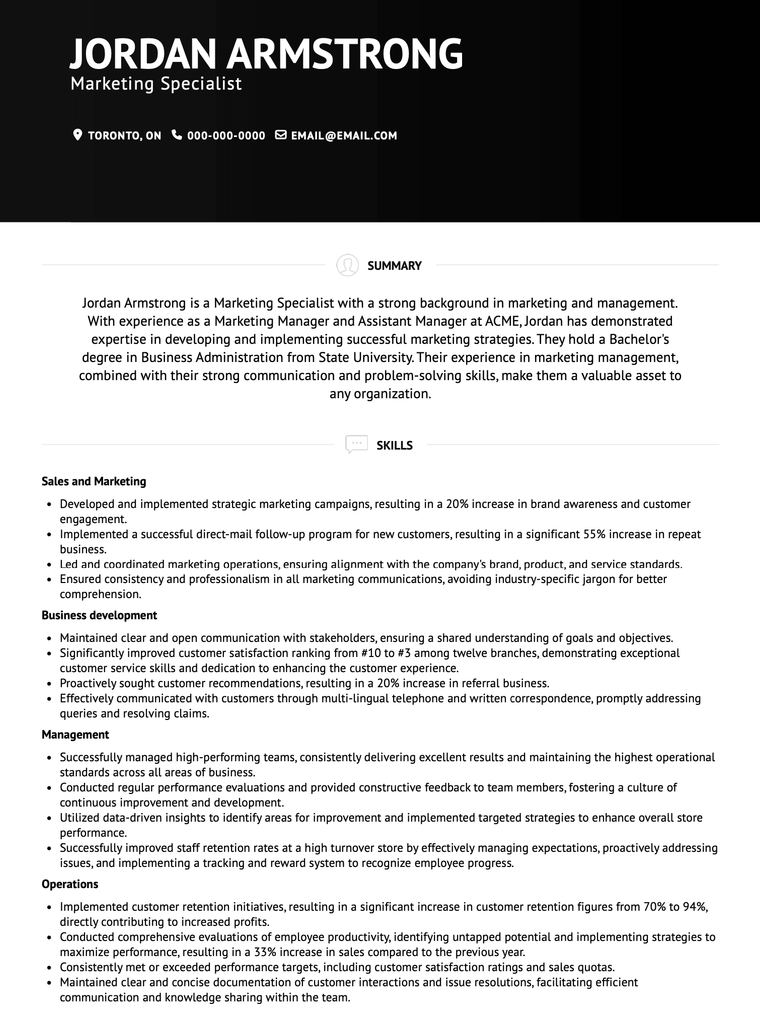
How a Hybrid resume Helps with Employment Gaps
- Skill Focus: By placing a strong emphasis on your skills, the hybrid resume directs attention to what you bring to the table, rather than gaps in your employment.
- De-emphasized Timeline: While still providing a work history, the timeline is less central, helping to downplay periods of unemployment.
- Demonstrating Continuous Growth: You can highlight how you have maintained or developed your key skills during gaps, whether through courses, freelance work, volunteer roles, or personal projects.
- Customizable Presentation: The flexibility of the hybrid resume allows you to present your professional narrative in a way that aligns your skills with the job requirements, creating a stronger impression.
A hybrid resume is ideal for addressing employment gaps, as it emphasizes key skills and achievements over a strict chronological work experience. This format allows you to showcase your capabilities and contributions while minimizing the focus on periods of unemployment.
How a Hybrid resume Helps with Career Changes
- Transferable Skills: Emphasize skills gained in previous roles that are applicable to your new career, even if the industries differ.
- Flexible Structure: The hybrid format allows you to strategically present your skills and accomplishments that align with your new career objectives.
- Minimized Focus on Irrelevant Roles: While still including a work history, the hybrid resume lets you downplay roles that are not directly relevant to your new path.
- Showcases Continuous Development: Highlighting relevant training, certifications, or personal projects that support your career transition.
Using hybrid resumes, career changers can effectively showcase their qualifications and demonstrate how their unique background and skills make them a strong fit for the new role, despite a different career trajectory.
Hybrid Resumes vs. Reverse Chronological Resumes
-
Emphasis:
-
Hybrid Resume: Prioritizes skills and achievements, making it suitable for career changers, those with gaps in employment, or varied job histories.
-
Reverse Chronological Resume: Focuses on presenting a clear, linear work history, ideal for candidates with a steady career progression(proven track record) in a single field.
-
-
Structure:
-
Hybrid Resume: Starts with a summary and a detailed skills section, followed by a concise work history and education.
-
Reverse Chronological Resume: Begins with a summary (optional), followed by a detailed work history listed from most recent to oldest, and then education.
-
-
Ideal For:
-
Hybrid Resume: Best for those wanting to emphasize transferable skills, downplay less relevant roles, or address employment gaps.
-
Reverse Chronological Resume: Suitable for individuals with consistent work experience, looking to highlight job titles, responsibilities, and career growth.
-
-
Flexibility:
-
Hybrid Resume: More adaptable for unconventional career paths.
-
Reverse Chronological Resume: Offers a straightforward, traditional approach preferred by many employers.
-
Hybrid Resume vs. Functional Resume:
-
Emphasis:
-
Hybrid Resume: Balances between showcasing skills and maintaining a concise professional history.
-
Functional Resume: Focuses exclusively on skills, achievements, and capabilities, often omitting the detailed timeline of roles.
-
-
Structure:
-
Hybrid Resume: Starts with a summary, followed by a detailed skills section, and a brief professional history.
-
Functional Resume: Begins with a skills summary, often grouping skills under categories without listing work history prominently.
-
-
Ideal For:
-
Hybrid Resume: Suitable for career changers, those with employment gaps, or varied job histories who still want to include a timeline of roles.
-
Functional Resume: Best for individuals who want to focus entirely on skills, such as those with minimal work experience, significant career gaps, or non-linear career paths.
-
-
Flexibility:
-
Hybrid Resume: Offers a middle ground, appealing to employers who want to see both skills and some career timeline.
-
Functional Resume: Often used when the candidate’s skills(soft and hard skills) are more relevant than their chronological work history.
-
Can a hybrid resume be used for all job applications?
A hybrid resume can be used for many job applications, but some traditional employers might prefer a reverse chronological format. It's important to tailor your resume to fit the job and industry, ensuring it meets the specific expectations of each employer.
How detailed should the work history be in a hybrid resume?
In a hybrid resume, work history should be concise, focusing on relevant roles and achievements. Highlight key positions without excessive detail, especially if the skills section covers major accomplishments. This ensures a balance between showcasing skills and providing a clear career timeline.
What industries prefer hybrid resumes?
Industries that prefer hybrid resumes include IT, healthcare, marketing, and project management, where both technical skills and consistent work history are valued. Creative industries also appreciate hybrid resumes for showcasing diverse skill sets effectively.
How long should a hybrid resume be?
A hybrid resume should typically be one to two pages, depending on your experience level. Focus on including only the most relevant skills, accomplishments, and work history to keep the resume concise and impactful.
How long should a hybrid resume be?
A hybrid resume should typically be one to two pages long, depending on your experience level. Focus on the most relevant skills, accomplishments, and work history to ensure the resume remains concise and impactful.
Can I use a hybrid resume for entry-level positions?
Yes, a hybrid resume can be effective for entry-level positions. It allows you to emphasize transferable skills, academic achievements, internships, and volunteer experiences, helping to demonstrate your qualifications despite limited professional work history.
How can I tailor a hybrid resume for different job applications?
To tailor a hybrid resume for different job applications, customize the skills and summary sections to highlight the most relevant skills and achievements. Adjust the wording to align with keywords from the job description, ensuring your resume matches the employer's needs.
What are the common mistakes to avoid in a hybrid resume?
Common mistakes in a hybrid resume include listing irrelevant skills, vague descriptions, excessive detail in work history, and failing to tailor the resume for each job. To avoid these, focus on clarity, relevance, and customizing the resume for the job application.
- What is a hybrid resume?
- Why should you write a hybrid resume?
- How to write a hybrid resume
- Hybrid resume example
- Hybrid resume templates
- How a Hybrid resume Helps with Employment Gaps
- How a Hybrid resume Helps with Career Changes
- Hybrid Resumes vs. Reverse Chronological Resumes
- Hybrid Resume vs. Functional Resume:
- Can a hybrid resume be used for all job applications?
- How detailed should the work history be in a hybrid resume?
- What industries prefer hybrid resumes?
- How long should a hybrid resume be?
- How long should a hybrid resume be?
- Can I use a hybrid resume for entry-level positions?
- How can I tailor a hybrid resume for different job applications?
- What are the common mistakes to avoid in a hybrid resume?

Written By
Ben Temple
Community Success Manager & CV Writing Expert
Ben is a writer, customer success manager and CV writing expert with over 5 years of experience helping job-seekers create their best careers. He believes in the importance of a great resume summary and the power of coffee.

The top hiring and human resource statistics for 2025, including data on AI resumes, job interviews, remote work, and recruiting.
January 1, 2025
Read Post

Community Success Manager & CV Writing Expert

Learning how to write a resume in 2025 is an important step in everyone's career. This step-by-step guide with resume examples will help you get started.
February 7, 2025
Read Post

Community Success Manager & CV Writing Expert
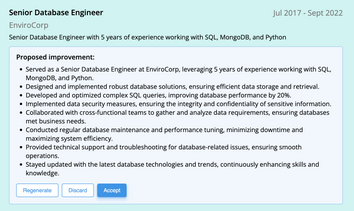
AI can change the way you write, and your resume is no exception.
November 27, 2023
Read Post

Community Success Manager & CV Writing Expert
Copyright ©2025 Workstory Inc.